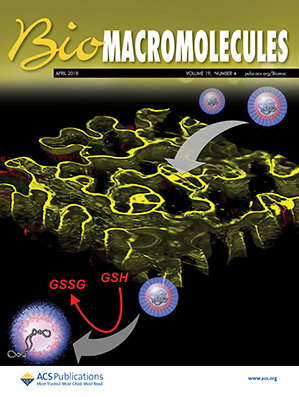基于修饰海藻酸钠的可注射和3d打印半互穿聚合物网络用于细胞球形形成。
IF 5.4
2区 化学
Q1 BIOCHEMISTRY & MOLECULAR BIOLOGY
引用次数: 0
摘要
我们报告了基于改性海藻酸盐基聚合物共混物组合的3d打印聚合物网络;制备了两种海藻酸盐聚合物,即P(NIPAM86-co-NtBAM14)-NH2共聚物链接枝的热响应聚合物和二醇/ ph敏感的3-氨基苯基硼酸修饰的第二种聚合物。凝胶性质由热敏链的疏水缔合和硼酸酯的形成决定。当热/二醇响应聚合物的混合比为70/30 wt %时,由于激发的交联协同作用,半互穿网络的最佳存储模量范围从20℃时的约150 Pa到37℃时的约480 Pa。结果表明,共混物可在24 h内快速形成平均直径为62.5 μm的细胞球状体。游离葡萄糖可作为交联的拮抗干扰物,使该网络易于解离。所提出的材料被发现是无毒的,具有足够的注射性和3D打印性。本文章由计算机程序翻译,如有差异,请以英文原文为准。
Injectable and 3D-Printable Semi-Interpenetrating Polymer Networks Based on Modified Sodium Alginate for Cell Spheroid Formation
We report on 3D-printable polymer networks based on the combination of modified alginate-based polymer blends; two alginate polymers were prepared, namely, a thermoresponsive polymer grafted with P(NIPAM86-co-NtBAM14)-NH2 copolymer chains and a second polymer modified with diol/pH-sensitive 3-aminophenylboronic acid. The gelation properties were determined by the hydrophobic association of the thermosensitive chains and the formation of boronate esters. At a mixing ratio of 70/30 wt % of the thermo/diol-responsive polymers, the semi-interpenetrating network exhibited an optimum storage modulus ranging from ca. 150 Pa at 20 °C up to ca. 480 Pa at 37 °C due to the stimulated cross-linking synergism. The resulting bioink blends could promote the rapid formation of cell spheroids with an average diameter of 62.5 μm within 24 h. The network could easily be dissociated by the addition of free glucose, acting as an antagonistic disruptor of the cross-links. The proposed material was found to be nontoxic, with adequate injectability and 3D printability.
- Download: Download high-res image (252KB)
- Download: Download full-size image
求助全文
通过发布文献求助,成功后即可免费获取论文全文。
去求助
来源期刊

Biomacromolecules
化学-高分子科学
CiteScore
10.60
自引率
4.80%
发文量
417
审稿时长
1.6 months
期刊介绍:
Biomacromolecules is a leading forum for the dissemination of cutting-edge research at the interface of polymer science and biology. Submissions to Biomacromolecules should contain strong elements of innovation in terms of macromolecular design, synthesis and characterization, or in the application of polymer materials to biology and medicine.
Topics covered by Biomacromolecules include, but are not exclusively limited to: sustainable polymers, polymers based on natural and renewable resources, degradable polymers, polymer conjugates, polymeric drugs, polymers in biocatalysis, biomacromolecular assembly, biomimetic polymers, polymer-biomineral hybrids, biomimetic-polymer processing, polymer recycling, bioactive polymer surfaces, original polymer design for biomedical applications such as immunotherapy, drug delivery, gene delivery, antimicrobial applications, diagnostic imaging and biosensing, polymers in tissue engineering and regenerative medicine, polymeric scaffolds and hydrogels for cell culture and delivery.
 求助内容:
求助内容: 应助结果提醒方式:
应助结果提醒方式:


